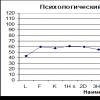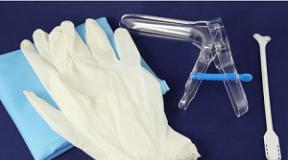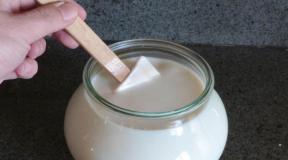Iodinol for the throat: instructions for use for children and adults. Iodinol - instructions for use, release form, dosages for children and adults, side effects and price Iodinol side effects
Iodinol is a dark blue antiseptic solution for external and local use. Possesses pronounced antimicrobial properties. The main active ingredient of the drug is molecular iodine.
Molecular iodine has pronounced antimicrobial properties. Molecular iodine preparations are characterized by a pronounced local irritating effect on tissues, and in high concentrations- cauterizing effect.
Local action due to the ability of iodine to precipitate tissue proteins. Preparations that split off iodine have a much less pronounced irritant effect, and iodides have local irritating properties only in very high concentrations.
When applied to large areas of the skin, iodine exhibits a resorptive effect: it enhances the processes of dissimilation, has a proteolytic effect, actively affects metabolism (metabolism) and participates in the synthesis of T3 and T4.
The excipient Iodinol reduces the irritating effect of iodine on tissues, and also slows down its excretion. Polyvinyl alcohol has a bactericidal effect on gram-negative (most active on E. coli and streptococci), gram-positive flora, pathogenic fungi and yeast. Ethanol has a detrimental effect on the anthrax pathogen spores. Staphylococci and Pseudomonas aeruginosa are more resistant.
Composition of 100 ml of Iodinol solution - 0.1 g of iodine, 0.3 g of potassium iodide and 0.9 g of polyvinyl alcohol.
Indications for use
What does Iodinol help from? According to the instructions, the drug is prescribed in the following cases:
- For external use: infectious and inflammatory skin lesions, trauma, wounds, myalgia.
- For local use: chronic tonsillitis, atrophic rhinitis, purulent otitis media, trophic and varicose ulcers, wounds, infected burns, fresh thermal and chemical burns of I-II degree.
- For oral administration: prevention and treatment of atherosclerosis, tertiary syphilis.
Application in gynecology is limited to antiseptic treatment of the operating surface.
Instructions for use of Iodinol, dosages for rinsing and processing
Topically, the drug is used to lubricate the tonsils, apply dressings, and for washing.
Preparation of rinsing solution - in 100 ml boiled water add Iodinol until the water turns dark yellow. The resulting solution is suitable for rinsing.
With chronic atrophic rhinitis produce throat rinsing and nasal irrigation. Before carrying out these procedures, you must first soften and then remove the crusts in the nasal passages. Gargling and nasal irrigation is carried out 2-3 times a week for 2 to 3 months.
Topically, Iodinol solution is used depending on the localization of the pathological inflammatory process:
- Tonsillitis - washing with a solution of tonsils lacunae every 3-4 days, the course of treatment is 5 washes.
- Pharyngitis - lavage of the pharynx 2-3 times a week for 2-3 months.
- Otitis media - the solution is instilled into the ear affected by the pathological process 2-3 times a week for 2-4 weeks.
With trophic and varicose ulcers, gauze napkins (in 3 layers) moistened with Iodinol solution are applied to the surface of the ulcer (pre-wash the skin with warm water and soap, and lubricate the skin around the ulcer zinc ointment). The dressing is carried out 1-2 times a day, while the gauze lying on the surface of the ulcer is not removed, but is again impregnated with the solution. After 4-7 days, a general or local bath is prescribed, then the indicated treatment is continued again.
For purulent wounds and infected burns, apply a loose gauze bandage soaked in the drug.
With fresh thermal and chemical burns of the I-II stage. a gauze bandage soaked in Iodinol is also applied, the inner layer of the bandage is irrigated with the drug as needed.
Side effects
The instruction warns of the possibility of developing the following side effects when prescribing Iodinol:
- When applied externally: rarely - skin irritation; at long-term use on extensive wound surfaces - iodism (rhinitis, urticaria, Quincke's edema, salivation, lacrimation, acne).
- Ingestion: cutaneous allergic reactions, tachycardia, nervousness, sleep disturbances, excessive sweating, diarrhea (in patients over 40).
Contraindications
It is contraindicated to prescribe Iodinol in the following cases:
- hypersensitivity to iodine.
For oral administration:
- pulmonary tuberculosis,
- jades,
- nephrosis,
- adenomas (incl. thyroid gland),
- furunculosis,
- acne,
- chronic pyoderma,
- hemorrhagic diathesis,
- hives,
- pregnancy,
- childhood up to 5 years.
Incompatible with essential oils, ammonia solutions, white sedimentary mercury (an explosive mixture is formed).
Overdose
With prolonged use, the phenomena of iodism are possible.
Symptoms are metallic taste in the mouth, possibly vomiting, stomach pain, and diarrhea. For 1-3 days, anuria, edema of the glottis with the following asphyxia, aspiration pneumonia or pulmonary edema are observed.
In some cases, severe circulatory disorders are possible.
Treatment is symptomatic. The patient is given milk or boiled starch to drink. Gastric lavage is performed. It is necessary to use activated carbon and 1-5% sodium thiosulfate solution. There is no specific antidote.
Analogs Iodinol, price in pharmacies
If necessary, Iodinol can be replaced with an analogue for the active substance - these are drugs:
- Alcohol solution of iodine,
- Iodonate,
- Yodopyrone.
When choosing analogs, it is important to understand that the instructions for the use of Iodinol, the price and reviews, do not apply to solutions of a similar action. It is important to consult a doctor and not make your own replacement of the drug.
Price in Russian pharmacies: Iodinol solution 100 ml - from 21 to 37 rubles, according to 487 pharmacies.
Store in a dark place at a temperature not lower than 0 ° C. Do not freeze!
Sale in pharmacies without a prescription.
Iodinol use in traditional medicineIodinol is blue iodine with antiseptic properties. The main active ingredient the drug is molecular iodine.
Unlike ordinary pharmaceutical iodine, blue iodine is not toxic, but also more aggressive. If taken orally in large doses, it can burn the lining of the stomach. To learn how to use the drug correctly, today we will talk about Iodinol, its use in traditional medicine in the treatment of various ailments.
For what diseases will Iodinol be used?
Most often, the drug is used for external use as lotions, rinses. Medical specialists recommend using the drug for the treatment of chronic tonsillitis, trophic ulcers, conjunctivitis, tonsillitis, otitis media, rhinitis, colitis, etc. It is used for healing wounds, burns, and is used for disinfection.
In case of injury, iodinol tampons moistened with the drug are applied to the wound for the fastest healing and disinfection of the wound.
To prevent the appearance of cysts on the teeth, you should rinse your mouth with a solution of soda and iodinol solution, alternately, at least 20 times in one day. This rinsing also successfully treats alveolitis and stomatitis.
In gynecology, the drug is used to get rid of thrush, to treat cracked nipples in breastfeeding women. Douching is done with it, tampons are put. The drug is also used to treat trichomoniasis.
Surgeons use it to treat wounds and ulcers infected with staphylococcus, streptococcus.
Blue iodine is the best treatment for burns. Apply a napkin soaked in a solution of iodinol to the damaged skin, then, as it dries, moisten it again without removing it from the skin. Then it will not dry out to the wound, and it will quickly heal.
If trophic ulcers appear on the legs, gently wash the skin together with the ulcer with warm water with baby or tar soap, pat dry with a soft towel. Lubricate the edges of the ulcer with pharmaceutical zinc ointment. Then apply a gauze napkin moistened with iodinol solution, apply a dry sterile napkin, a cotton swab on top, secure the bandage with a bandage. Change it every 12 hours.
In this case, do not remove the napkin with the drug solution, just moisten it again without removing it from the ulcer.
If, a week after the start of the procedures, a profuse discharge of pus begins, the ulcer should be washed well again, then the treatment should be continued.
With angina, inflammation of the tonsils, the throat is smeared with cotton wool wound on a stick moistened with iodinol solution, and the throat is also washed with it. The course of treatment is 2 times every other day. A total of 10 procedures should be carried out. The treatment can be repeated only after 2-3 months. For children school age it is better to lubricate the throat rather than rinse it out.
How to make blue iodine at home?
You can prepare an analogue of iodinol at home and also use it to get rid of various ailments.
To do this, pour 50 ml of water into a glass bowl, add 1 tsp. starch, 1 tsp. granulated sugar, on the tip of a citric acid knife. Boil 150 ml of water separately, add the mixture from the bowl, stirring thoroughly. You get a jelly that needs to be cooled.
Then pour in 1 tsp. pharmacy tincture of ordinary iodine. The solution turns blue. This "blue iodine" can be used for treatment.
This remedy can be taken in 1 tsp. per day for an adult for the prevention and replenishment of iodine deficiency in the body. This should be done in autumn or spring, but not more than 1 month.
For flu, colds, as well as for their prevention, it is also useful to take this remedy, no more than 3 times a week.
The use of Iodinol in folk medicine has also proven to be effective in food poisoning... In these cases, a weak solution of the drug is taken orally.
For diseases of the stomach, intestines, colitis, enterocolitis, peptic ulcer a small amount of the drug (0.5 tsp per 1 tbsp) is added to fresh apricot or plum juice. At the same time, pathogenic bacteria are destroyed, allergic diseases pass.
Traditional medicine also uses iodinol to treat mastopathy. For this, compresses are made from the drug, which are then tightly applied to the chest. Special compresses can be bought at the pharmacy, or you can do it yourself.
Moisten a thick, soft piece of clean cloth with iodinol solution, lay it to the breast, put cotton wool on top, cover with plastic, put on a bra. Do not remove the compress for 2 hours. After removing the compress, do not wash your chest.
Warning
The use of Iodinol requires attention and caution. Do not use the drug together with hydrogen peroxide or other disinfectants.
Be healthy!
Iodinol is medicine, the main composition of which includes iodine, calcium iodide and polyvinyl-type alcohol.
The drug has antiseptic, anti-inflammatory properties and a unique healing effect. Use the medicine in the treatment of tonsillitis, rhinitis, tonsillitis, of various types pharyngitis. In addition, the drug is effective in the occurrence of purulent wounds after surgery, as well as chemical burns in the area of the gastrointestinal tract.
In this article, we will consider why doctors prescribe the drug Iodinol, including instructions for use, analogues and prices for this drug in pharmacies. If you have already used Iodinol, leave feedback in the comments.
Composition and form of release
Pharmacological group: antiseptic, disinfectants, halogens.
The drug iodinol is an antiseptic solution that comes to pharmacies in vials of 100 milliliters in volume. The solution contains the required amount of substances such as iodine, potassium iodide and polyvinyl alcohol.
What is Iodinol used for?
The drug Iodinol is used to treat the following diseases:
- chronic tonsillitis;
- chronic atrophic rhinitis (or ozena);
- chronic suppurative otitis media;
- purulent surgical diseases;
- chronic periodontitis;
- trophic, varicose ulcers;
- thermal, chemical burns.
Also, the drug Iodinol can be used for the purpose of antiseptic treatment of the operating field.
pharmachologic effect
Antiseptic. It is a product of the addition of molecular (crystalline) iodine to polyvinyl alcohol.
The main active ingredient of iodinol is molecular iodine, which has antiseptic properties. Polyvinyl alcohol is a high-molecular compound, the content of which in iodinol slows down the release of iodine and lengthens its interaction with body tissues; also reduces the irritating effect of iodine on tissue.
Iodinol has a bactericidal effect on both gram-positive and gram-negative flora, as well as pathogenic fungi and yeast, most active on streptococcal flora and Escherichia coli. Pseudomonas aeruginosa is resistant to local application iodinol. Iodinol is low toxic.

Instructions for use
When applied externally, damaged skin areas are treated with iodine. For oral administration, the dose is set individually, depending on the indications and age of the patient.
Locally used for washing lacunae and supratonsillar spaces - 4-5 procedures at intervals of 2-3 days, for irrigation of the nasopharynx - 2-3 times a week for 2-3 months, for instillation into the ear and rinsing - for 2-4 weeks; in surgical practice and in case of burns, gauze napkins applied to the affected surface are moistened as needed.
Contraindications
Hypersensitivity to iodine. For oral administration - pulmonary tuberculosis, nephritis, nephrosis, adenomas (including the thyroid gland), furunculosis, acne, chronic pyoderma, hemorrhagic diathesis, urticaria, pregnancy, children under 5 years of age.
Side effects
In the vast majority of cases, the use of the drug in the recommended doses and with the correct methods of administration does not cause any negative reactions. Instructions for the use of iodinol indicate that when used externally, skin irritation is very rarely possible; with prolonged use, iodism may occur (lacrimation, salivation, acne, rhinitis).
Ingestion: allergic skin reactions, tachycardia, sleep disturbances, nervousness.

special instructions
The drug should be used only in stationary conditions. Avoid getting Iodinol in the eyes. Temperatures above 40 ° C and light accelerate the decomposition of active iodine. Discoloration of the solution indicates a decrease in the effectiveness of the drug due to the destruction of the complex with the transition of active iodine to iodide ion.
The diluted solution (should have a dark brown color) is not subject to long-term storage.
Analogs
Analogues of Iodinol include Lugol's solution with glycerin, iodine solution
Prices
The average price of Iodinol in pharmacies (Moscow) is 12 rubles.
Storage conditions
Do not store iodinol in the light, do not freeze.
Iodine is one of the safest and most time-tested medicines. Its use in medicine began in the middle of the 19th century, and a jar of iodine is still present in every family medicine cabinet. Preparations based on this have proven themselves well. chemical element... One of them, Yodinola, will be discussed today. We will consider what Iodinol helps from, instructions for using this remedy, as well as contraindications to its use.
Composition of the preparation
Iodinol is water solution, which includes:
- 0.1% iodine;
- 0.3% potassium iodide;
- 0.9% polyvinyl alcohol.
The solution mixes easily with water, has a dark blue hue and an odor characteristic of iodine. Resistant to long-term storage. In a closed container with room temperature does not lose its properties for 3 years.
What is the difference between Iodinol and ordinary iodine?
Its main difference and advantage is the delayed elimination of molecular iodine, which is achieved due to the presence of polyvinyl alcohol. This ensures a longer effect of the drug on the treated tissues, thereby increasing the therapeutic effect and reducing the risk of irritation. In addition, unlike ordinary iodine, Iodinol is completely non-toxic.
Price
To evaluate another advantage of the drug, just look at how much Iodinol costs in the pharmacy. The price for a 100 ml bottle of liquid Iodinol ranges from 12 to 30 rubles. The form of release in the form of an aerosol is somewhat more expensive, its cost is within 100 rubles.
What does Iodinol help from?
The drug has a pronounced bactericidal effect, therefore it is used as an antiseptic. It is effective in the fight against both gram-positive bacteria (staphylococcus, Escherichia coli, Proteus, etc.), and with most of the gram-negative (Helicobacter pylori, Salmonella, as well as bacteria that cause sexually transmitted diseases). Helps to cope with yeast and pathogenic fungi.
What does Iodinol treat:
- sore throats, rhinitis, tonsillitis, including in a chronic form;
- pneumonia (acute and chronic);
- dysentery;
- ulcerative colitis;
- chemical and thermal burns(skin, eyes, mucous membranes);
- purulent wounds, skin ulcers, boils;
- inflammatory eye diseases (conjunctivitis, etc.);
- diseases of the oral cavity (gingivitis, stomatitis, etc.);
- mastitis;
- gynecological diseases (thrush, erosion).
This is far from full list of what Iodinol helps from, because its bactericidal properties can be used in the fight against almost any infectious diseases... The only thing that the drug does not cure is an infection caused by Pseudomonas aeruginosa. This type of microorganism is absolutely resistant to iodine.
Contraindications and side effects
Considering any drug, not only its benefits are taken into account, but also harm. Therefore, we will analyze the cases in which the use of Iodinol can cause a negative reaction.
Contraindications for the drug include:
- hypersensitivity to its individual components;
- thyrotoxicosis and other disorders in the thyroid gland;
- acne at treatment sites;
- age up to 6 years;
- pregnancy;
- period of breastfeeding.
Iodinol is safe only if the recommended dosages are strictly observed. In case of excess, the so-called iodism (iodine overdose) may appear. It has the following symptoms:
- the taste of metal in the mouth;
- increased salivation;
- pain and burning sensation in the throat;
- redness of the eyes;
- swelling of the face;
- breathing problems;
- irritation of the skin and mucous membranes;
- digestive disorders.
If an overdose is caused by ingestion of the drug, it is required to immediately flush the stomach. If the reaction to external use is negative, the product is washed off the skin with a 2% baking soda solution.
We examined what Iodinol is, what it is treated with and in what cases its use is undesirable. Next, we turn directly to the methods of using Iodinol in folk medicine.
How to use Iodinol for respiratory diseases
The drug is able to quickly relieve inflammation and sore throat. This is a time-tested remedy number 1 for sore throats. Treatment is carried out by gargling the throat.
Before gargling with Iodinol for angina, the drug must be diluted with water. Otherwise, you can get swelling of the mucous membrane.
How to dilute a gargle adults:
- The most common proportion is 1 tbsp for 1 cup of boiled water. funds.
- If a standard concentration solution causes a burning sensation in the throat, add dessert instead of a tablespoon of the product.
Rinsing with the resulting solution should be carried out 3 times a day. If the sore throat is very severe, the number of procedures can be increased to 4. For one rinse, 50 ml of the solution is enough, and its duration should not exceed 2 minutes. Such treatment must be carried out for 4-5 days.
These rinses also have a positive effect. with ARVI, pharyngitis, laryngitis, and even help from a fungus in the throat.
Antiseptics, disinfectants, halogens.
Contact of the drug with the skin leads to the formation of iodides, the release of active iodine. These substances determine the bactericidal, antimycotic properties of iodinol.
The product is produced as a 1% aqueous solution, which contains 0.1 g of iodine, 0.3 g of potassium iodide, 0.9 g of polyvinyl alcohol per 100 ml.
Iodinol is packaged in bottles of orange, dark glass, plastic, packed in a box, instructions for use are attached to the product.
 The solution has a dark blue color, as you can see in the photo, for this iodinol was called “blue iodine”, it is diluted with water, foams well, and has a specific smell of iodine.
The solution has a dark blue color, as you can see in the photo, for this iodinol was called “blue iodine”, it is diluted with water, foams well, and has a specific smell of iodine.
A convenient form of iodinol release is a spray with a spray nozzle, the volume of a bottle is 50 ml. Application in the form of a spray allows you to more accurately dose the drug according to the instructions when treating wounds, ulcers, and treating the nasopharynx.
Iodinol decomposes under the action of alkalis, sunlight, therefore, the medicine is stored in a dark glass container.
The drug iodinol is an aqueous solution of a substance that is a complex formation of iodine with polyvinyl alcohol. Its pharmacological activity is determined by the antimicrobial, antifungal properties of iodine.
 The drug is active against E. coli, pathogenic yeast-like fungi, gram-positive, gram-negative microorganisms, is able to suppress the activity of antibiotic-resistant strains of staphylococci.
The drug is active against E. coli, pathogenic yeast-like fungi, gram-positive, gram-negative microorganisms, is able to suppress the activity of antibiotic-resistant strains of staphylococci.
Iodinol is not effective against Pseudomonas aeruginosa.
Polyvinyl alcohol is a high molecular weight synthetic compound that binds iodine in iodinol, which creates the effect of slow release of the active substance during treatment.
The gradual release of iodine during treatment with iodinol reduces its irritant effect.
The drug improves the functioning of the thyroid gland, blood composition, condition blood vessels with atherosclerosis. In high concentrations, iodine has a cauterizing effect on tissues.
Iodinol solution is used for rinsing with angina, thrush, stomatitis, purulent otitis media, chronic tonsillitis, ozena, atrophic rhinitis, atrophic laryngitis. The drug is used to treat purulent wounds, trophic, varicose ulcers, thermal, chemical burns, frostbite.
Iodinol is active against the yeast-like fungi Candida, they are successfully treated with thrush, cutaneous candidiasis.
The bactericidal properties of the drug are used in the treatment of dysentery, nonspecific colitis, Trichomonas colpitis, gynecological diseases, they are treated for poisoning with mercury, lead, endemic goiter, hyperthyroidism.
 The drug is not used for intolerance, thyrotoxicosis, pregnancy.
The drug is not used for intolerance, thyrotoxicosis, pregnancy.
For children, iodinol is prescribed after reaching the age of five.
Iodinol is contraindicated in patients suffering from pulmonary tuberculosis, tumors of various origins, nephrosis, nephritis, skin rashes, hemorrhagic diathesis.
Iodinol is used externally and administered internally. How local remedy the drug is used in gynecology, surgery for the treatment of purulent wounds.
The solution is used to lubricate the skin, irrigate, rinse, instill in diseases of the ear, nasopharynx, sore throat. Tertiary syphilis, atherosclerosis is treated by taking medicinal solution inside.
 Iodinol is used to treat sore throats, tonsillitis, gum disease, stomatitis.
Iodinol is used to treat sore throats, tonsillitis, gum disease, stomatitis.
To wash the lacunae with inflammation of the tonsils, 4-5 procedures are performed every 2-3 days. To gargle with iodinol, you need 50 ml of the drug per gargle. With a sore throat, it is allowed to use iodinol more often, up to 3-4 times a day.
Iodinol lubricate the throat with purulent sore throat 2-3 times a day for 5 days.
With stomatitis, gingivitis, alveolitis of the oral mucosa, rinse with iodinol for a week up to 3 times a day.
Iodinol for preparing a liquid for gargling is supposed to be diluted according to the instructions:

Another method of preparing a composition for gargling a throat, mouth for stomatitis, sore throat is less accurate. A mouthwash is obtained by diluting a spoonful of iodinol in a glass of water.
With stomatitis, after tooth extraction, to reduce pain, including in children after 5 years, soda rinses and rinses with iodinol are alternated.
 Vaginal candidiasis (thrush) is treated by douching with iodinol diluted with water in a 1: 1 ratio. The disappearance of symptoms is observed after the first douching.
Vaginal candidiasis (thrush) is treated by douching with iodinol diluted with water in a 1: 1 ratio. The disappearance of symptoms is observed after the first douching.
For a complete recovery from thrush, it is necessary to simultaneously treat both sexual partners, to rinse with a diluted 1: 1 solution of iodinol.
You can find out more about candidiasis and methods of treatment in our article Causes and treatment of candidiasis in women.
Iodinol is used against nail fungus caused by a yeast-like fungus from the Candida family.
Before starting treatment, you need to accurately establish the type of fungus that caused the deformation of the nail.
A cotton pad is moistened with medicine, applied to the nail, covered with polyethylene, bandaged. The compress is kept for 5 days, changing twice a day.
For the next 2-3 days, a compress is applied to the nail with olive oil... The procedure helps to soften the nail, cleanse it from candida fungus.
You can learn more about candidal nail fungus in the article Mold and candidal onychomycosis.
A gauze napkin is moistened with iodinol and applied to the surface of the wound. As the solution dries, the napkin is moistened without removing it.
With this method of wound treatment, a dry crust does not form, the bandage does not stick to the skin, and the iodine in iodinol disinfects and heals tissue damage.
Trophic ulcers with varicose veins are also treated with iodinol. To do this, a napkin moistened with medicine is applied to a previously well-washed and dried wound.
The edges of the ulcer should be smeared with zinc ointment, and the wound itself can be treated for the best healing effect with lime water.
The compress is bandaged, the treatment is continued for 3-5 days. The dressing is done 2 times a day, all this time the dressing is moistened with iodinol. If pus is released, change the dressing more often.
With purulent otitis media, iodinol is instilled into the ear in 5-8 drops.
Iodinol is used to treat atrophic rhinitis. Before using iodinol, it is necessary to cleanse the nasal cavity from crusts:

After treatment, the nasal cavity and nasopharynx are irrigated with iodinol, with atrophic rhinitis, the procedure is repeated after 2-3 days for 3 months.
Inside, the medicine is taken after meals, with atherosclerosis, 5-12 drops are added to milk and drunk 1-2 times a day for a month.
Iodinol is not combined with preparations containing ammonia. Blue iodine cannot be used with essential oils.
The activity of the agent decreases when taking lithium preparations, in an alkaline, acidic environment, in the presence of blood, pus in the wound during treatment.
If the instructions for the use of iodinol are violated, iodism may occur - tissue inflammation caused by an overdose of iodine.
When taking iodinol inside, tachycardia (rapid heart rate), sweating, insomnia, diarrhea may occur.
At the site of application of iodinol to the skin, there may be a burning sensation, in large doses it reduces lactation, in small doses, on the contrary, stimulates the release of milk in lactating women.
If salivation increases as a result of treatment with iodinol for fungus, rinsing the throat, the appearance of Quincke's edema or other phenomena not specified in the instructions for use, it is necessary to rinse the stomach and immediately call a doctor.
Iodinol is easy to prepare yourself. For this, 9 g of polyvinyl alcohol is placed in a glass container with a volume of 1 liter, 0.8 liters of water is poured, and left to swell.
After the polymer swells, which will take from 1 to 6 hours depending on the conditions, it is placed on a slow fire and heated for 30-60 minutes at a temperature of 90-100 degrees.
The result should be a clear solution, into which, after cooling down, add 150 ml of an aqueous solution of 1 g of crystalline iodine and 3 g of potassium iodide.
The solution of polyvinyl alcohol will turn blue. Then the total volume of the drug is brought to 1 liter with water, mixed well, packaged, stored in a cool, dark place, avoiding freezing, in a place inaccessible to children.
Under these conditions, iodinol can be stored for up to 3 years.
Self-made medicine is used to treat both children and adults, as indicated in the instructions for use of the pharmacy iodinol.
Analogs of iodinol include Lugol's solution with glycerin, iodine solution.
 The price, effectiveness of Lugol's solution, subject to the instructions, according to customer reviews, practically do not differ from those of iodinol. This is explained by the fact that the active substance of the analogs is elemental iodine.
The price, effectiveness of Lugol's solution, subject to the instructions, according to customer reviews, practically do not differ from those of iodinol. This is explained by the fact that the active substance of the analogs is elemental iodine.
The price of iodinol in a 50 ml spray averages 60-80 rubles in Russia, the cost of a 100 ml solution of iodinol in Russia is 70 rubles, in Ukraine - 165 hryvnias.
Do not store iodinol in the light, do not freeze.
Surely in every first-aid kit there is a bottle of antiseptic iodine - it is customary to use it to treat damage to the integrity of the skin to prevent infection. On the basis of this component, many drugs have been created, not only for local application to tissues, but also for internal administration, which already carries a completely different target load. We propose to consider one of these means - Iodinol antiseptic solution.
This drug is available in vials and is intended for local and external use. 100 ml of the product contains - 0.1 grams of iodine, 0.3 grams of potassium iodide and the rest of the volume is polyvinyl alcohol. The main active ingredient of the drug is considered to be molecular iodine itself, which has a pronounced disinfecting effect. Polyvinyl alcohol also plays an important role among the ingredients - it allows you to slow down the release of iodine when using a solution, which significantly lengthens the period of beneficial interaction with the treated tissue site. In addition, the alcohol component is designed to reduce the irritating effect of iodine on the skin. Local action is due to the ability of iodine to precipitate tissue proteins.

Thus, the main task for which the solution is used is an antiseptic effect. The drug is low-toxic, and is capable of exerting a bactericidal effect on both gram-positive and gram-negative microflora (in particular, staphylococci, Escherichia coli, fungi and yeast are affected).
The product is intended for local use in order to destroy pathogenic microflora or prevent its appearance. Thus, the application is possible with the following ailments:
- tonsillitis;
- otitis media (including in the presence of purulent discharge);
- inflammation of the tissues around the tooth root;
- purulent diseases requiring surgical therapy;
- ulceration in places of dilated veins;
- long-term healing damage to the skin;
- thermal and chemical burns;
- some fungal tissue lesions;
- infectious and inflammatory lesions of the skin.
Use in each individual situation can only be prescribed by a doctor, since excessive ingestion of iodine into the body and its inactivity with respect to the causative agent of an existing infection can lead to unpleasant consequences and complications.
The use of such a simple drug in its composition has its limitations and requires strict adherence to the instructions. For example, in case of purulent wounds and burns that have been infected, a gauze bandage soaked in the composition is applied to the affected area, after which it is replaced with a new one as necessary. In general, the method of application, proportions and duration of the course are determined by the specific situation.

Quite often, gargling with Iodinol is practiced, in particular when the throat is infected (for example, with sore throat). However, the composition is concentrated and very aggressive, and its use in its pure form can lead to chemical burn, therefore, before disinfecting rinses, it is required to properly dilute the drug. So, the proportion is considered standard - a tablespoon in a glass of clean water, while the liquid should acquire a bluish tint. In case of severe sore throat, you can rinse up to 4 times a day, rinsing out one glass each time. The procedure should be carried out carefully, in the process it is worth tilting your head back and trying to skip the composition as low as possible, but at the same time not allowing it to be swallowed.
Inflammation of the mucous membrane in oral cavity can also be effectively eliminated with Iodinol by destroying pathogenic microflora. Again, due to its active irritating effect, the composition must be previously prepared - diluted in proportion with water in a ratio of one to three, after which the resulting agent can be used to lubricate the damaged areas on the mucous membrane. The frequency of lubrication is 2-3 times a day, and after 3-4 days the first results will be noticeable.
When applied to the mucous membrane, children should dilute the drug more strongly, using a ratio of one to five. The resulting product can be used to lubricate the stomatitis zones, and to rinse the oral cavity with a weak solution of a slightly bluish color.
Rhinitis, which is accompanied by purulent discharge, indicates the active development of pathogenic microorganisms in the nasal cavities. To suppress their growth and reproduction, Iodinol can be used - it is added to water in a small amount until a weak blue solution is obtained. Adults with a similar composition can make a "cuckoo" by thoroughly washing the sinuses on both sides, and for children it will be enough to drip a few drops into each nostril, and then either suck off the mucus, or ask the baby to blow his nose.
As mentioned above, an antiseptic can also cope with fungal infections, which led to its use in gynecology. So, with thrush in women, provoked by a fungus of the genus Candida, two methods are used - laying tampons and douching. For both procedures, Iodinol is used, diluted with warm water in a ratio of 1 to 3. To achieve the best therapeutic effect, these activities alternate with each other, making 1 cycle per day until the onset of improvement.
With a fungal infection nail plates Compresses with Iodinol are applied for 5 days. So, to the affected area, you need to apply gauze folded in several layers and well soaked in the product, and leave in this form for half an hour. When defeated on initial stages treatment of the nail will be enough cotton swab dipped in the preparation, 2-3 times during the day.
Despite the fact that in the recipes traditional medicine you can find recommendations for taking the drug in question inside, in practice it is not recommended to implement this. So, in the instructions for Iodinol, it is clearly stated that its use internally provokes an overdose and the occurrence of pronounced side symptoms. In order to normalize the level of iodine in the body, other agents are prescribed that are specifically intended for oral administration.
In the event that the use of the drug is made according to the requirements of the instructions and the recommended dosage is observed, then no problems arise. However, a situation is possible when the patient has an intolerance to iodine or other components of the composition of the drug, and then symptoms of impaired respiratory function, skin allergic reactions, local tissue irritation may appear.

A state of acute overdose occurs if the drug is deliberately or accidentally ingested, that is, it enters the body orally. Against this background, the classic symptoms of iodism are formed, that is, an overdose of iodine, namely:
- the appearance in the mouth of a pronounced metallic taste;
- active saliva separation;
- sore throat, burning sensation;
- swelling of the eyelids, redness of the eyes due to their irritation;
- difficulty breathing;
- the formation of skin reactions;
- severe disorders of the digestive process, in particular cramps, vomiting, diarrhea.
This condition requires symptomatic therapy and careful monitoring of thyroid function.
It is worthwhile to get away from the local use of the solution in question when there are contraindications, namely:
- hypersensitivity to iodine and other components of the solution;
- diseases of the thyroid gland;
- the product of therapy with radioactive iodine;
- children under 6 years of age;
- the presence of severe tissue irritation at the site of the planned application of the composition;
- acne in the treatment area.
The use of the drug during pregnancy and breastfeeding is allowed only with a doctor's prescription, and only for a short course - up to 5 days with the condition of processing a small tissue area. It should be borne in mind that the manufacturer classifies the period of bearing the baby as a contraindication, since even when applied to the skin, the components penetrate into the bloodstream, from there they pass through the placental barrier or penetrate into breast milk.
Iodinol can be easily purchased at any pharmacy, and at a very affordable cost. A structural analogue that would completely repeat the composition of this drug, does not exist, however, the group of antiseptics is very wide, and the following products have similar properties:
- Malavit;
- Lizak;
- Fluomisin;
- Furacilin;
- Decatilen, etc.
Lera: I used Iodinol myself, getting rid of nail fungus. At first it seemed that it was not helping, but after a month of procedures, the problem left me.
Yana: A common, readily available drug. I bought it for gargling with sore throat - the doctor prescribed it. Within the framework of the complex of treatment, the effect was good.
Kristina: The most important thing is to dilute this product when used for mucous membranes! Otherwise, edema is guaranteed.

iodine
First way:
To do this, place 9 grams of polyvinyl alcohol in an enameled or stainless steel dish with a volume of 1 liter, pour 700-800 ml of it. water and leave for 1-6 hours to swell. Then heat the vessel to 90-100 ° C for 0.5-3 hours to obtain an almost clear solution. Cool it to room temperature and add 3 ml to it. commercial hydroiodic acid specific gravity 1.4. Then the entire resulting solution is brought to a volume of 1 liter with water. A dark blue liquid is obtained, which is stored in a closed glass vessel at an ordinary temperature of 3 to 30 ° C. This is a completely harmless iodinol. It is stored for three years or more.
Second way:
Pour 800 ml of water into any enamel or glass vessel with a capacity of 1 liter, add 9 g of polyvinyl alcohol and leave for 2-3 hours for the polymer to swell. After that, heat the mixture for 30-60 minutes over low heat to a temperature of 90-100 ° C until a colorless transparent solution is obtained. Cool to room temperature and add 150 ml of an aqueous solution of 1 g of crystalline iodine and 3 g of potassium iodide to it. In this case, the solution turns dark blue. Bring up the volume of liquid to 1 liter and mix well. The solution is ready for use. Transfer it to small glass containers and store at room temperature in a dark place.
If iodinol is used in recommended doses, then there should be no negative reactions. However, in people with hypersensitivity or individual intolerance to the components of the drug, irritation of the oral mucosa and allergic reactions may occur. And with prolonged use, in rare cases, iodism may even occur, which is manifested by rhinitis, rash, lacrimation and salivation. Also, a contraindication to the use of iodinol is thyrotoxicosis, iodism, pregnancy and breastfeeding. Contraindications are also intolerance to ethyl alcohol.
An apple is a real storehouse of nutrients. These fruits contain trace elements such as potassium, calcium, magnesium, sodium, iron, phosphorus, copper, fructose, pectins, essential oils, vitamins A, B, C, P, etc. Apples are also valued for dietary fiber or fiber. If you eat at least one apple every day, you will forget about constipation forever. Since they contribute to the normalization of work gastrointestinal tract and increase appetite. These fruits are very rich in pectins, which help to bind and remove excess cholesterol formed in the liver.
Treatment of chronic tonsillitis with medicinal plants
Tonsillitis (tonsillitis; from Latin tonsilla - amygdala) - inflammation of the tonsils. Tonsillitis can be acute (acute inflammation of the tonsils, i.e. tonsillitis) and chronic. It is necessary to distinguish the difference between honey inflammation of the tonsils and the nasopharyngeal tonsil or lingual tonsil. Tonsillitis is a disease of young and even children. Chronic tonsillitis insidious - gives serious complications. The palatine tonsils (tonsils, as the people say) are an accumulation of lymphadenoid tissue and have the most complex structure in comparison with other tonsils.
Hardening procedures with cold and hot water
We all strive for comfortable living conditions. What would be the same temperature in the house in which we live all year round. We dress warmly in the winter, cool ourselves under the air conditioners in the summer. And it would seem that under such ideal conditions they should get sick less. But in practice it turns out differently. There has not been a single year that the flu and colds did not grow into an epidemic of just a nationwide scale. And only a few can boast that they practically do not get colds.
Fir, medicinal properties, recipes 
Fir is one of the most beautiful conifers with a pyramidal crown. Sometimes it reaches simply enormous proportions. Belongs to the genus of evergreen conifers of the pine family (Pinaceae), numbering 35-40 species. Fir trees are widespread in temperate and cool regions of North and Central America, Eurasia and northern Africa.
Fir does not grow in areas with polluted air, it grows in clean ecological places. Fir forests are especially widespread in Altai and Sayan Mountains. The plant loves to grow in rich, moist loamy soil.
Treatment of the heel spur with alternative methods 
Heel spurs develop as a result of acute and chronic injuries, flat feet, gout, and various infections.
Symptoms of this disease are pains of varying intensity on the plantar surface of the heel during exertion. Most often, heel spurs form on the sole, sometimes on the back of the calcaneus.
And if, as a result of the examination, you have been diagnosed with such a diagnosis, you can apply and folk ways which are very effective.

Iodinol has recently been very difficult to find in pharmacies, but earlier this medicine was considered simply miraculous for many diseases. Only after the appearance of new preparations of antibiotics and sulfonamides, iodinol faded into the background. But it was used not only by our grandmothers, but also by official medicine and with great success.
Treatment of various pharyngitis, tonsillitis and tonsillitis previously could not be imagined without iodinol. This old, proven tool is still relevant today.
Iodinol is an aqueous solution consisting of iodine (0.1%), potassium iodide (0.9%) and polyvinyl alcohol. Has a very characteristic smell of iodine, foams well and mixes with water. The color of the liquid should be dark blue.
It has the ability to decompose in light and in an alkaline environment. therapeutic effect, since when applied to mucous membranes, iodinol slowly cleaves molecular iodine - a strong antiseptic and anti-inflammatory substance, and after disintegration it improves metabolism.
And the polyvinyl alcohol included in the composition, slowing down the release of iodine in the preparation, significantly helps to reduce irritation from iodine and also lengthens the effect on the treated tissues of the body. Iodinol, in contrast to elemental iodine, is completely non-toxic, but still more aggressive and in high doses, when taken orally, can cause mucosal burns. Therefore, it is mainly used in the form of rinses and lotions externally.
This drug has a strong bactericidal effect on yeast and pathogenic fungi, gram-negative bacteria and gram-positive - especially Escherichia coli and Staphylococcus aureus. Even more resistant staphylococcus, with prolonged use in 80% of cases under the influence of Iodinol dies.
But it must be borne in mind that Pseudomonas aeruginosa is resistant to iodinol. It is a very stable preparation, and at room temperature, in a sealed glass container, it can be stored for 3 years or more.
The drug is not toxic at all and therefore is used in the treatment of many diseases both locally and internally, intramuscularly, intravenously and intraarterially in doses up to 2-3 ml per 1 kg of patient weight per day.
Treatment with iodinol for trichomoniasis.
Since trichomoniasis urinary tract both in men and women, it very often leads to stagnant cystitis. And in men, it can contribute to the appearance of chronic prostatitis, accelerates the development of adenoma prostate... Therefore, it is advisable to get rid of trichomoniasis, which is present in 70–80% of all practically healthy people, before treating chronic prostatitis.
For effective treatment trichomoniasis in women, daily rubbing with iodinol of the mucous membranes of the vagina, urethra, and cervical canal is used. The procedure is carried out 2-3 times a day. Then a vaginal bath of 15–20 ml of iodinol solution is needed. The course of treatment is up to 10 procedures. Douching, tampons, rubbing and smearing with iodinol are very effective in gynecology.
Just as often (especially in men), iodinol solution is injected directly into bladder... To do this, using a syringe without a needle, 15–20 ml of iodinol is injected every other day. The required number of procedures is 5–7.
It's not safe for babies to lubricate nipples. iodine, greenery, even honey (allergy!). And iodinol is harmless.
This is how it is treated trophic ulcers on my feet at varicose veins veins and diabetes mellitus Irrigation, tampons, rinsing, dressings with iodinol can be used.
One of the methods of treatment: the sore spot together with the ulcer must be washed with hot water, soap and a brush. To improve the effect, you can use sessile water. Wipe with a sterile cloth and grease the edges of the ulcer with zinc ointment. Put a three-layer gauze soaked in iodinol on the ulcer, put a dry napkin on top, a little cotton wool and fix it all. The dressing is done twice a day.
When changing the bandage, the three-layer gauze lying on the wound is not touched, but moistened abundantly with iodinol. If after 3-5 days a profuse pus is released, then you need to take a bath and continue the treatment further. If there is a little pus, then a hot bath should be done only after 7 days.
And from burns iodinol too best remedy... To do this, a bandage previously moistened with iodinol solution is applied to the burn. For a good effect, then from time to time it is necessary to moisten it without removing it. Since constantly wet gauze does not dry out to the wound, and iodine has bactericidal properties and the wound heals quickly.
Otolaryngologists often use Iodinol for angina to flush the lacunae of the tonsils and supratonsillar space. Single dose the drug is 50 ml. For complete cure carry out 4 procedures in 2 days.
You can also use iodinol on your own for rinsing your throat. But a safe solution must be prepared. Add the medicine drop by drop to a glass of boiled warm water. And as soon as the solution acquires a dark yellow color, you can start treatment.
However, a less accurate medot can also be used. Add a glass of water to 1 tablespoon of the drug. In acute sore throat with severe pain, gargle often. Every 4 hours. And when medium severity 3 times a day.
In addition to gargling, iodinol can be used to lubricate the throat with purulent sore throat. To do this, cotton wool should be screwed onto a pencil or stick. Then dip it in a slightly diluted solution and lubricate the tonsils. If this procedure is carried out 2-3 times a day for 5 days, then the pain decreases by 2-3 days.
Iodinol is also used for stomatitis. But children can use this medicine for stomatitis only in the form of rinsing. With the prepared solution according to the above method, it is necessary to irrigate the mucous membrane of the mouth 3-4 times a day for a week. If you use Iodinol for stomatitis in recommended doses, then there should be no negative reactions.
And rinsing the mouth with iodinol after tooth extraction helps to remove the swelling of the cheeks much better than rinsing with furacilin. It can also be used for chronic cysts on the roots of the tooth, alternately rinsing with solutions of soda and iodinol 20 times a day.
Rinsing the inflamed oral mucosa 4 times a day relieves inflammation and pain not only with stomatitis, but also with gingivitis and alveolitis.
Iodinol is also very successfully treated by some eye diseases... For example, conjunctivitis is quickly cured. For this, 2-3 drops of iodinol are instilled into the eye 4 times a day.
And in case of eyelid injuries, the wound is irrigated, and then tampons moistened with iodinol solution are put in. The same method is used to treat eye inflammations, burns, and corneal injuries.
Iodinol is successfully used in surgery for the healing of stubborn wounds, ulcers that are infected with staphylococcus and streptococcus, are insensitive to antibiotics.
Iodinol is used and how disinfectant when handling the hands of surgeons and obstetricians-gynecologists.



















